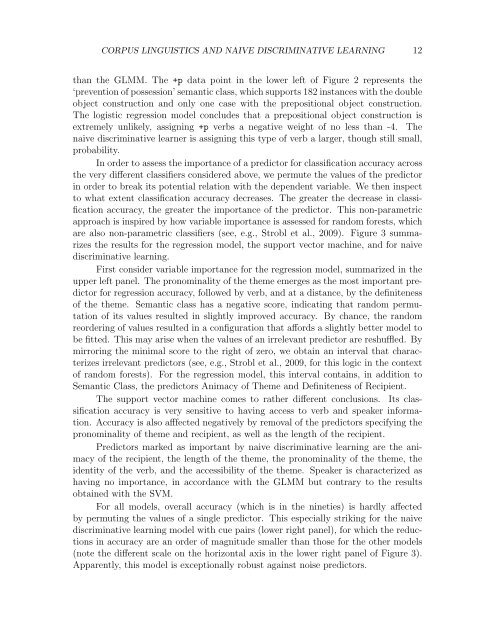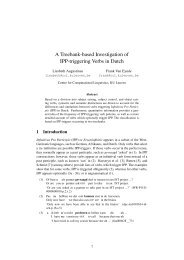Corpus linguistics and naive discriminative learning - University of ...
Corpus linguistics and naive discriminative learning - University of ...
Corpus linguistics and naive discriminative learning - University of ...
You also want an ePaper? Increase the reach of your titles
YUMPU automatically turns print PDFs into web optimized ePapers that Google loves.
CORPUS LINGUISTICS AND NAIVE DISCRIMINATIVE LEARNING 12<br />
than the GLMM. The +p data point in the lower left <strong>of</strong> Figure 2 represents the<br />
‘prevention <strong>of</strong> possession’ semantic class, which supports 182 instances with the double<br />
object construction <strong>and</strong> only one case with the prepositional object construction.<br />
The logistic regression model concludes that a prepositional object construction is<br />
extremely unlikely, assigning +p verbs a negative weight <strong>of</strong> no less than -4. The<br />
<strong>naive</strong> <strong>discriminative</strong> learner is assigning this type <strong>of</strong> verb a larger, though still small,<br />
probability.<br />
In order to assess the importance <strong>of</strong> a predictor for classification accuracy across<br />
the very different classifiers considered above, we permute the values <strong>of</strong> the predictor<br />
in order to break its potential relation with the dependent variable. We then inspect<br />
to what extent classification accuracy decreases. The greater the decrease in classification<br />
accuracy, the greater the importance <strong>of</strong> the predictor. This non-parametric<br />
approach is inspired by how variable importance is assessed for r<strong>and</strong>om forests, which<br />
are also non-parametric classifiers (see, e.g., Strobl et al., 2009). Figure 3 summarizes<br />
the results for the regression model, the support vector machine, <strong>and</strong> for <strong>naive</strong><br />
<strong>discriminative</strong> <strong>learning</strong>.<br />
First consider variable importance for the regression model, summarized in the<br />
upper left panel. The pronominality <strong>of</strong> the theme emerges as the most important predictor<br />
for regression accuracy, followed by verb, <strong>and</strong> at a distance, by the definiteness<br />
<strong>of</strong> the theme. Semantic class has a negative score, indicating that r<strong>and</strong>om permutation<br />
<strong>of</strong> its values resulted in slightly improved accuracy. By chance, the r<strong>and</strong>om<br />
reordering <strong>of</strong> values resulted in a configuration that affords a slightly better model to<br />
be fitted. This may arise when the values <strong>of</strong> an irrelevant predictor are reshuffled. By<br />
mirroring the minimal score to the right <strong>of</strong> zero, we obtain an interval that characterizes<br />
irrelevant predictors (see, e.g., Strobl et al., 2009, for this logic in the context<br />
<strong>of</strong> r<strong>and</strong>om forests). For the regression model, this interval contains, in addition to<br />
Semantic Class, the predictors Animacy <strong>of</strong> Theme <strong>and</strong> Definiteness <strong>of</strong> Recipient.<br />
The support vector machine comes to rather different conclusions. Its classification<br />
accuracy is very sensitive to having access to verb <strong>and</strong> speaker information.<br />
Accuracy is also afffected negatively by removal <strong>of</strong> the predictors specifying the<br />
pronominality <strong>of</strong> theme <strong>and</strong> recipient, as well as the length <strong>of</strong> the recipient.<br />
Predictors marked as important by <strong>naive</strong> <strong>discriminative</strong> <strong>learning</strong> are the animacy<br />
<strong>of</strong> the recipient, the length <strong>of</strong> the theme, the pronominality <strong>of</strong> the theme, the<br />
identity <strong>of</strong> the verb, <strong>and</strong> the accessibility <strong>of</strong> the theme. Speaker is characterized as<br />
having no importance, in accordance with the GLMM but contrary to the results<br />
obtained with the SVM.<br />
For all models, overall accuracy (which is in the nineties) is hardly affected<br />
by permuting the values <strong>of</strong> a single predictor. This especially striking for the <strong>naive</strong><br />
<strong>discriminative</strong> <strong>learning</strong> model with cue pairs (lower right panel), for which the reductions<br />
in accuracy are an order <strong>of</strong> magnitude smaller than those for the other models<br />
(note the different scale on the horizontal axis in the lower right panel <strong>of</strong> Figure 3).<br />
Apparently, this model is exceptionally robust against noise predictors.
















